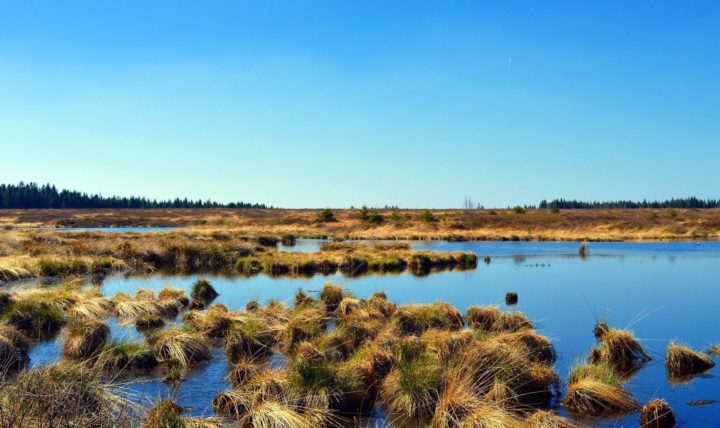Peatlands and Trees could be cornerstone of Defra Net Zero Strategy
Defra’s new England Peat and Trees Action Plans attempts to address greenhouse gas emissions from UK's land
By Matt Williams
Share
Last updated:
You might well think that the UK’s green and pleasant land is a perfect ally in tackling climate change, able to soak carbon dioxide out of the atmosphere and store it as carbon in the leaves, trunks and roots of our much-loved flora and in the soils beneath. And while that is true, the degraded state of a swathe of our countryside means it is, in the lingo, a ‘source’ as opposed to a ‘sink’ of carbon, releasing more carbon than it sucks up. In real terms its output is equivalent to more than half of the emissions from industry. Not quite so green and pleasant.
The UK’s land was previously recorded as absorbing 10.3 million tonnes of greenhouse gases in 2019, but with peatland properly included, this turns into an overall release of 5.9 million tonnes of greenhouse gases. The main culprit here is peat, thought to be emitting millions of tonnes of greenhouse gases a year due to people drying, burning and generally degrading peatlands. But also in the frame is the comparatively bald nature of our landscapes: a lack of trees. Just 13% of UK land has tree cover, whereas Germany weighs in at 33%, Spain at 37%, and Sweden at a heavyweight 68%. These are problems in need of a plan. Cue Defra’s new England Peat and Trees Action Plans.
The world is watching

A raft of sector plans and strategies are due this year which will piece together to make up the Government’s Net Zero Strategy expected in September. Due to be published just weeks before the UK holds the global COP26 climate summit in November, the strategy is designed in part to show that the nation has a plan for its target, is a credible climate leader and ergo host of the COP.
How we use our land should put the ‘net’ in net zero, balancing out residual emissions from difficult to decarbonise sectors. Indeed our peatlands have been described as the UK’s rainforests for the vast quantities of carbon they can soak up and store.
Sadly like many of the world’s great forests they are currently in a sorry state. The UK wants to lead the world in nature restoration with its pledge to set aside 30% of land for nature by 2030 and by encouraging other countries to do the same.
But the state of the UK’s nature and wildlife place it bottom of the G7 league table for biodiversity. So, do these plans match the lofty ambitions?
How to grow a forest

Perhaps the key plank of the Trees Action Plan is the new source of funding (yet to be confirmed how much) to support tree planting next to rivers and on farms. The Plan also includes new funding for incorporating trees into farms and fields.
Many farmers are already taking steps to increase tree cover on their land, including those showing that trees and food production don’t necessarily need to be in competition with each other.
The Woodland Trust recently found that only 7% of existing woods and trees are in a good state, so the plan also includes a new category of ‘Long Established Woodlands’ designed to increase protection for existing trees and woods.
Measures to increase ‘biosecurity’ and protect against importing diseases that kill trees, to support native trees, and improvements that benefit wildlife as well as the climate are welcomed by green groups. The powers and duties of the Forestry Commission are also set to be updated to better reflect the nature, carbon-storing, and commercial value of trees.
Increasing commercial forests could provide jobs in managing them, but the Plan also recognises that a balance needs to be struck between broadleaf and conifer species. Some experts have warned that a return to the planting of forests on sensitive peatland soils (last seen in the post-war years) should be avoided, proposed changes to the UK Forestry Standard could help achieve this.
The Government has reiterated its target for tree cover in England to be increased from 10% to 12% by 2050. The Climate Change Committee recommends that tree cover in the UK as a whole should reach 18% by 2050, meaning that much of the heavy lifting could be left to Scotland, Wales, and Northern Ireland. Given that this 12% target was set in 2013 before net zero was a legally binding goal, is this enough and will the Government increase it in the future?
Getting bogs back to good health

As regards the Peat Action Plan, perhaps the most significant step is a consultation on phasing out the use of peat in compost. The Government plans to consult on phasing out the use and sale of peat in compost by 2024 - at present 2 million cubic metres are sold and exported from the UK each year, but the UK actually imports a large proportion of this from peatlands in the Republic of Ireland and Europe. The Action Plan also underlines the Government’s commitment to restore 35,000 hectares by 2025 although it commits ten times less funding (£50 million) than it does to trees (£500 million).
The Lowland Peat Agricultural Taskforces will report next year on the best approach for sustainably managing lowland peatlands. Lowland peatlands (found in places like Cambridgeshire) are different from those in the uplands - they are used for a combination of horticulture, arable, and grazing and are some of the most productive soils in the country. Support for farmers to shift to sustainable farming methods on these sensitive soils will be critical.
The Government says it will keep its ban on burning peatlands under review and consider extending it beyond protected sites where it applies at the moment. Natural England and the Climate Change Committee have said burning on peatlands should be banned or phased out except in exceptional circumstances; whether and when the Government decides to go further than the measures introduced this month remains to be seen.
Where next for Defra?
Land is only part of the emissions that Defra has responsibility for. It also has oversight of emissions from agricultural production (the use of energy and chemicals such as fertilisers, and emission released by livestock) which are greater than those from land. The Government also has a plan here, including the new Environmental Land Management system for England that will reward farmers for environmental outcomes. In the coming months we will see how Defra includes agriculture in the Government’s wider Net Zero Strategy, and how it responds to the forthcoming National Food Strategy which may contain proposals for how the farmed countryside and the food system can play its role in reaching net zero.
Share